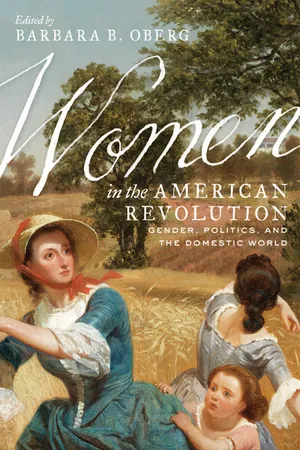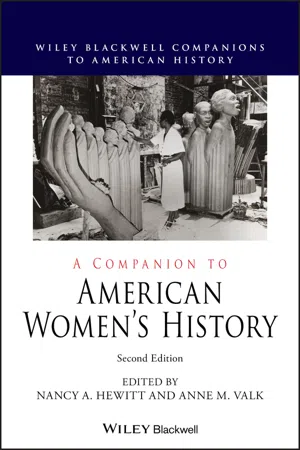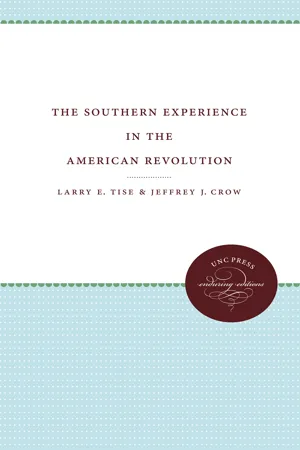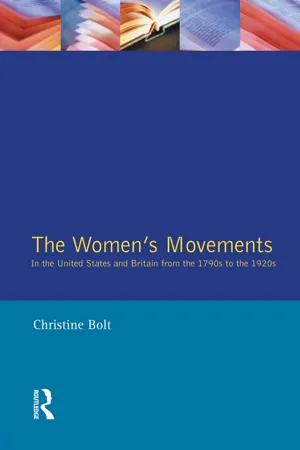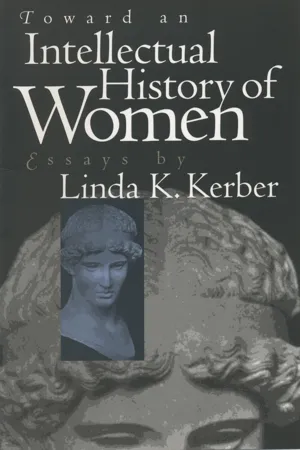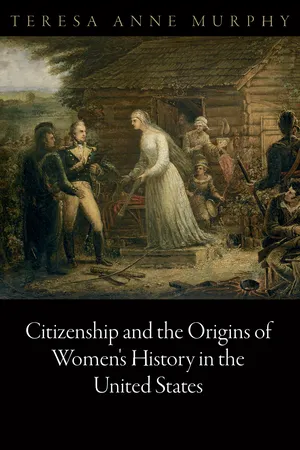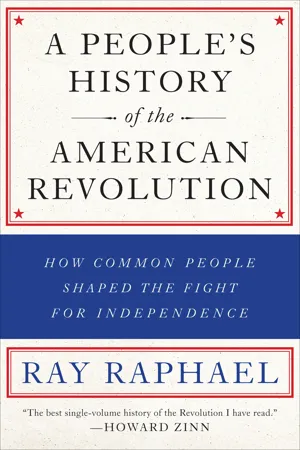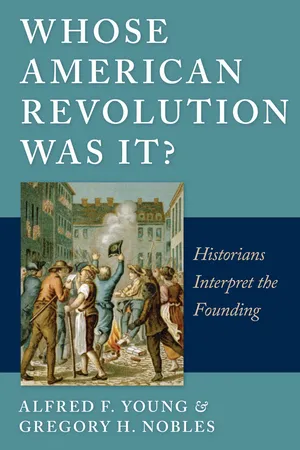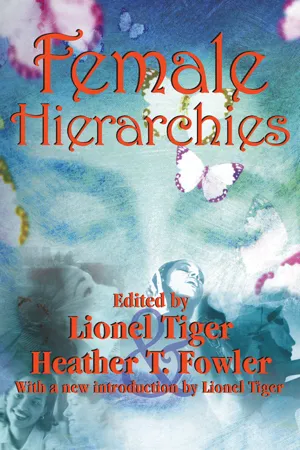History
Women in the American Revolution
Women played a significant but often overlooked role in the American Revolution. They contributed in various ways, such as managing households and businesses, providing support to soldiers, and even participating in combat. Some women also became outspoken political activists and writers, advocating for women's rights and contributing to the revolutionary cause. Their contributions helped shape the outcome of the revolution and laid the groundwork for future advancements in women's rights.
Written by Perlego with AI-assistance
Related key terms
10 Key excerpts on "Women in the American Revolution"
- eBook - ePub
Women in the American Revolution
Gender, Politics, and the Domestic World
- Barbara B. Oberg, Barbara B. Oberg(Authors)
- 2019(Publication Date)
- University of Virginia Press(Publisher)
Introduction Rosemarie ZagarriWhat did the American Revolution mean to—and for—women? Only within the past half-century has this question come to be considered a valid and important topic of scholarly inquiry. Among previous generations of historians, the American Revolution was assumed to be by, for, and about men—usually white men, who were often of elite status. These were, after all, the individuals who led the armies, fought the battles, and gathered in legislative assemblies to create a new government for the country. Changes within the field of history, however, have challenged the conventional narrative. With the development of social history in the 1970s, women’s history in the 1980s, and gender history in the 1990s, scholars and nonscholars alike have come to realize that one cannot fully understand the American Revolution without understanding women’s participation in, and contributions to, the revolutionary movement. Yet not all women supported the revolutionary cause. Like some men, certain women remained loyal to the Crown. In addition, it has become clear that those on the margins of the Revolution, including lower-class white women, enslaved women, free black women, and Native American women, should have a place in accounts of the period. Willingly or not, these groups often found themselves swept up in the revolutionary maelstrom.1Women played an integral role in all phases of the revolutionary process: in the prerevolutionary movement to resist British policies, in the struggles during the War for Independence, and afterward, in efforts to build a new nation. Nonetheless, after decades of scholarship on this topic, there is still no consensus on a critical question: did the Revolution benefit women or actually reinforce traditional gender roles? For white women, much of the attention thus far has been on their political or legal status, which, at least on the surface, did not change much. The doctrine of coverture, which declared women legally subordinate to their husbands or fathers, persisted. Married women could not own property, make contracts, or sue (or be sued) in court. Women did not win the vote (except briefly in New Jersey); nor could they hold public office. They remained legally invisible.2 - eBook - ePub
- Nancy A. Hewitt, Anne M. Valk, Nancy A. Hewitt, Anne M. Valk(Authors)
- 2020(Publication Date)
- Wiley-Blackwell(Publisher)
Chapter Five Women and the Long American RevolutionSerena ZabinAs a colonial rebellion that fractured complex relationships between Britain and America, as a war that ended or upended the lives of millions, and as the foundation of a new political nation that made novel claims to the basis of its political authority, the American Revolution was not a single event. Its foundational language of liberty and its assertions of equality have been emphasized by historians over many generations, but those same claims make it easy to dismiss the Revolution as either irrelevant to women or as hypocritical in its aims. The scholarship of the last thirty years, moreover, has made clear that the category of woman is itself nearly meaningless in the eighteenth century. As scholars increasingly focus on the intersections of gender with economic status, age, ethnicity, and race, the question of whether women had a revolution – the focus of several early studies – seems less relevant. This shift was already apparent when Jan E. Lewis analyzed women in the era of the Revolution for the 2002 edition of A Companion to American Women’s History. That change in perspective now dominates the field.In the past two decades, historians have responded to the complex relationship of gender, identity, and revolution in two ways. Some have produced studies, many of them excellent, on particular subsets of eighteenth‐century women’s lives, not all of which even acknowledge the presence of the American Revolution. Conversely, others have attempted to break down the impact of the Revolution or the importance of its various actors by separating out categories of white, black (both free and enslaved), and indigenous women. This second approach has had the unexpected effect of revealing much more about race than about gender. As white men gained increasing political power regardless of social status, so did white women, if more slowly. Changes that the Revolution wrought on the institution of slavery – both its limitations and expansions – affected men and women together. Similarly, the Revolutionary War shattered native homelands and devastated men and women equally, although not in the same way. - Larry E. Tise, Jeffrey J. Crow(Authors)
- 2017(Publication Date)
- The University of North Carolina Press(Publisher)
2 That focus is too narrow for a number of reasons. First, it is highly likely that a majority of female Americans did not participate actively on one side or the other; but because those women did not directly affect the war, does that mean that the war had no effect on them? Second, a narrative of women’s activities during the war, while interesting in itself, tells us little about the meaning of those activities for the women involved. How did they perceive themselves and assess their experiences during the war years? Did their lives change in any way as a result of those experiences? Third, female blacks as well as whites lived through the wrenching years of warfare, yet few discussions of women in the Revolution mention them. Finally, the lives of women in the revolutionary era must be considered within the context of the times. The American Revolution was far more than just a war: it was also a search for a national identity, a social and economic upheaval of major proportions, a time of government building. These aspects of the Revolution no doubt affected women at least as directly as did the actual fighting.This essay is an attempt to confront such questions as they relate to the lives of women in the South from roughly the 1760s through the 1780s. It does not pretend to be definitive, but rather suggests an approach to women’s history in the late eighteenth century that stresses the effects of the Revolution; that explicitly connects social and economic circumstances to the shaping of women’s roles; and that encompasses the experiences of women from various racial, political, social, and economic backgrounds.I
Before one can assess the impact of the Revolution on southern women, one must begin by outlining the patterns of women’s lives in the South in the years prior to the war. Those lives centered largely upon the household. Without today’s—or even the nineteenth century’s—labor-saving devices, female colonists had to spend the vast majority of their time caring for the needs of their families. But just as the economic conditions, geographic locations, and sizes of colonial households varied, so, too, did the duties and roles of the women within those households. For the purposes of this analysis, it is best to distinguish three separate types of households in which southern women led quite different lives: first, the rural homes of the poorer and “middling” parts of the white population; second, the urban households inhabited by members of the same group; and third, the large, multiracial households (whether rural or urban) that contained both the wealthiest whites and the black Americans who served them, the latter usually constituting a numerical majority of the family.3- Christine Bolt(Author)
- 2014(Publication Date)
- Routledge(Publisher)
In the basic contours of their lives, American and British women were essentially alike: excluded from politics, accorded an inferior education, seen as possessing unique feminine traits, leading domestic lives, uncomfortably placed if single, and taking pleasure in their children, female friends and religion. There was no distant golden age for women in either country, though economic freedoms had been greater and political activities a little less circumscribed in the early modern period than they were in the mid-eighteenth century. Yet, as we have seen, by then there were the first signs of changing attitudes and expectations among women regarding marriage and children, and they had established a position in the churches, especially the Protestant denominations, which indicated both the actual and potential power of female moral energy. New forces of change and reaction in politics, ideas, religion and the economy in the last quarter of the eighteenth century stirred up areas of women’s life where there was formerly no flux, accelerated movement in areas where alteration was already under way, and raised expectations which could not always be realised. In so doing, they simultaneously prepared the way for woman as feminist and reformer, and for the Victorian notion of the ‘angel in the house’. The experience of the Revolution also helped to implant in American women a sense that they enjoyed special advantages and responsibilities: a belief which, however much nineteenth-century feminists may have exaggerated the blessings of their own past, was to become an important feature of their campaign.II. Forces for change
(i) The American Revolution
The American Revolution, as Kerber, Norton and Countryman point out, had a profoundly politicising effect on the female population of the colonies. Among women and colonial leaders alike, it forced an unusual awareness of women’s importance as consumers and potential boycotters of British imports, producers of vital goods and general managers of the household economy. As the conflict with Britain affected their daily lives, took away their husbands and divided their families, women assumed men’s jobs, debated political issues and became less apologetic about doing so than they had once been. They participated in crowd actions as a vital part of their communities, petitioned Revolutionary governments and local committees of safety in pursuit of their interests as wives and mothers, and – in Pennsylvania, New Jersey and Maryland – raised money to help the war effort.76These new activities brought women no direct political return. Averting political tyranny and ensuring the survival of the young republic were more important objectives than sexual or racial equality for its male politicians and political theorists. Countryman has shown that only groups which ‘had established their political identity in the Revolution’ were subsequently ‘in a position to struggle for their concerns’; and women, like non-whites, had not effectively done so.77 Such ventures as boycotts and the homespun production drive unfortunately looked like a mere extension of traditional female undertakings,78 and women’s support was freely given and promptly accepted without apparently provoking any sense that a reward might be appropriate.79 As a result, women had difficulty in obtaining war widows’ pensions after hostilities ended, and they were enfranchised only by New Jersey, which in 1776 gave the vote to all its free adult inhabitants. Although the Revolution was not embarked upon to create a democracy, it did encourage a further democratisation of the suffrage; the meagre consequences of this process for women are therefore particularly disappointing. By 1807, blacks and women had been disenfranchised even in New Jersey, on the grounds that they were the elements most liable to manipulation in the state’s corrupt political system.80- eBook - ePub
Gender and American Culture
Essays By Linda K. Kerber
- Linda K. Kerber(Author)
- 2017(Publication Date)
- The University of North Carolina Press(Publisher)
Rosenkrantz and Guildenstern Are Dead: a world that has been turned inside out so that we can pay attention to voices that were present in the original telling but overpowered by the narrator’s choice of central characters.There is much merit to thinking of the era as an “age of the democratic revolution,” and to melding the French and American upheavals into a single set of shared events on a large scale. Lafayette’s career alone may furnish all the proof we need of the merits of that approach. But there were also enormous differences between the political cultures of the two revolutions, a difference that is underscored by the sharp differences in women’s behavior. French women were early to claim their political tongues, beginning with the cahiers of the flower sellers of Paris and proceeding through Olympe de Gouges’ ”Declaration of the Rights of Woman” and the activities of the Society of Revolutionary Republican Women.2 For these collective activities we have no direct counterparts in America. When Rachel Wells petitioned the Continental Congress, she petitioned alone.Indeed, virtually the only mechanism the American republic made available to Rachel Wells was the traditional mechanism of the individual petition, which forces deference and subservience on the claimant. The music of her words is in the counterpoint: there is the tone of the forceful demand (“Now gentelmen is this Liberty”) in which she addresses her readers as an equal; against it rings the tone of the mendicant (“God has spread a plentifull tabel for us & you gentelmen are ye Carvers”). Reading her petition, we learn something about her social status (poor), her role during the revolutionary war (contributor and supporter), and finally her hesitant articulation of the meaning and significance of that experience. - Teresa Anne Murphy(Author)
- 2013(Publication Date)
- University of Pennsylvania Press(Publisher)
18In the colonies as well, women had become increasingly involved in the politics of the American Revolution so that their civic engagement had moved beyond their drawing rooms to independent and direct activities. Their status as consumers and producers put them at the center of the political boycotts of British goods that began in the 1760s, and their social exchanges sometimes became political, a point that has been made by Barbara Clark Smith, Kate Haulman, Susan Branson, and Rosemarie Zagarri. When bands of women in towns throughout the northeast forced merchants to adhere to price controls set by local councils, they entered the realm of revolutionary politics in a manner previously unknown. Elite women, more than men, found their fashions subject to political scrutiny, particularly when they wore clothes of luxurious fabrics that suggested European influence. Beyond their clothes, however, their drawing rooms also became politicized as women actively engaged in discussion about military battles, government intrigue, and the French Revolution. By the end of the Revolution, women had become much bolder about petitioning the government concerning grievances; in New Jersey, a few women even achieved the right to vote for almost two decades after the Revolution.19In addition, some women in the new republic celebrated election day and attended civic events. They were present at parades and at the dinners that followed. They were toasted by the men for their patriotism and for their support for political causes. “As their happiness depends on Federal Union,” one man toasted, “may their influence be exerted in its support.”20 They gave vocal support to the candidates of their choice in a wide variety of social circumstances. Indeed, as women continued to discuss politics in the increasingly polarized political world of the 1790s, some boldly called themselves “female politicians.”21- eBook - ePub
A People's History of the American Revolution
How Common People Shaped the Fight for Independence
- Ray Raphael(Author)
- 2011(Publication Date)
- The New Press(Publisher)
44By rioting, ordinary women exercised power in a setting outside the narrow confines of their separate and individual households; they explored an intriguing interface between private and public realms. Even if they were not “perfect statesmen,” these common folk engaged in collective action that made a difference.Women and the ArmyWhile upper-class women learned to make do with fewer luxuries, and while farm and working-class women stayed home and tended to business, those with no business to tend—thousands of poor wives or widows or runaway servants who had nowhere else to go—submitted to the harsh, migratory lifestyle of the professional army. “Camp followers,” they were called.45 They served the army as cooks, washerwomen, and nurses; during battles they carried messages and supplies and assisted with the artillery. These poor women cast their lots with the army because they had few other options. Since the vast majority were illiterate, and none left any diaries, we can only conjecture whether they felt liberated or exploited by the work they were required to perform.Officers of the Continental Army were never quite sure how to deal with the women who followed the troops. On some level they sensed that women, particularly those who accompanied their husbands, were necessary to keep up the morale of the men; without women, Washington wrote, the army would “lose by Desertion, perhaps to the Enemy, some of the oldest and best Soldiers in the Service.”46 But should the army actually support these women? If it gave them no rations, the women would starve—yet rations were always scarce, even for the men. For most of the war, decisions concerning allocations to women were left to the discretion of local commanders; sometimes women received full rations, sometimes half, occasionally none at all. In 1780 officers at West Point were ordered to issue provisions to women only if they washed clothes at “a Reasonable Rate.”47 In 1783, as the war was winding down, the American high command was still debating the ticklish issue of rations for camp followers.48 - eBook - ePub
A War of Ideas
British Attitudes to the Wars Against Revolutionary France, 1792–1802
- Emma Vincent Macleod(Author)
- 2019(Publication Date)
- Routledge(Publisher)
Yet the impositions of this war upon the British people in terms of military participation, vulnerability to a French invasion and liability for providing the material resources required to finance the war effort brought the conflict directly into the lives of most British women as well as men. In terms of direct military involvement, however, women could at most be spectators, not actors, in the drama. Eighteenth-century warfare was a fundamentally male-dominated phenomenon. As necessary spectators, therefore, their views hold interest in the context of the war debate. What did women think about the conflict, and how did they express their opinions? Moreover, how does their involvement in the war debate fit into the historiographical model of 'separate spheres' of influence and activity for men and women in the 1790s?The difficulties of attempting to assess the significance of the written attitudes of British women to the wars against revolutionary France are largely concerned with lack of evidence. Those women who left detailed written records of their opinions on the conflict were usually exceptional people as well as unusual women for their time, and they are few in number. Furthermore, men wrote much of the literature directed at women. The Lady's Magazine and other periodicals for women were edited by men and mostly written by men; and, while several pamphlets were signed by 'an Englishwoman' or 'Britannia', the text suggests that they were written by men. For these reasons, the following sections rely mostly on texts whose authorships are reasonably certain.Yet the question of female views on the war is important enough, though generally neglected, to be considered seriously on the basis of what evidence there is. Their opinions were naturally often very similar to those of men, but it is arguable that, whatever part of the social or political spectrum they represented, women consistently emphasized certain issues and concerns. Moreover, not only were they trying to answer the questions posed also for men by the conflict but, in a war which had a direct impact on a very wide cross-section of society over such a long period of time, they also struggled with the question of their own role in a society at war. This chapter examines women's contributions to Britain's pamphlet debate on the conflict, as well as journals and letters written by women, in order to gain insight into women's views on the war. In doing so, it also tries to shed light on the ways in which they conceptualized desirable female behaviour during the war. It ends by examining men's attitudes towards women's participation in the conflict and in the debates surrounding it. - eBook - ePub
Whose American Revolution Was It?
Historians Interpret the Founding
- Alfred F. Young, Gregory Nobles(Authors)
- 2011(Publication Date)
- NYU Press(Publisher)
256Long before women could become manufacturers, much less “ladies” in the republic, though, they had to contribute to the creation of that republic, which occasionally meant engaging in other than ladylike behavior. In the tumult of revolutionary times, women almost always appeared on the scene in political demonstrations and riots, sometimes on the sidelines as spectators to major events, sometimes as worshipers or mourners or exhorters, and sometimes as active participants in open protest. That last category, of course, took them beyond the standard patterns of what their society considered “acceptable” political behavior. Barbara Clark Smith argues in her exploration of food riots in Revolutionary America that no matter how much women may have been “politically disabled by their dependent status,” they broke the constraints commonly associated with their gender: in dozens of instances they became quite politically active when they took part in, even organized, forceful protests against price-gouging merchants thought to be hoarding food or selling it at an exorbitant cost. Although drawing on political traditions of the “moral economy” and popular regulation that reflected longstanding European precedents, the women who engaged in food riots in Revolutionary America also reacted to the more immediate context of crisis in their communities. Indeed, Smith argues, their “capacity to act within a local, plebeian public arose … from embeddedness in a community.” Turning on local shopkeepers who seemed to be working against the common good, they identified their own communal protest as part of the larger Revolutionary cause, claiming that “confronting merchants in their shops was a patriotic action, much like facing redcoats on the battlefield.”257 - eBook - ePub
- Lionel Tiger, Heather T. Fowler(Authors)
- 2017(Publication Date)
- Routledge(Publisher)
7 Women in Politics WILLIAM O’NEILLIn a brief paper one cannot do more than discuss a few episodes in the political history of women during the past two centuries. The task is made all the more difficult because professional historians have largely neglected women until very recently. All the same, the evidence that exists does permit a few tentative generalizations. One is that, except under special circumstances, women have never participated in politics on an equal basis with men, whatever their legal status. Another is that women did not participate in politics as women at all until the French Revolution. Of course, women were politically active as individuals long before that. Numerous wives, mothers, courtesans, and queens made their mark on history before the age of revolution, but indirectly as a rule and never as members of female political movements.1Even as late as the American War of Independence, to the success of which many women contributed, their labors were seldom well organized and only marginally political. And for the most part, their work was consistent with prevailing doctrines as to women’s role and capacity (Clinton and Green 1912). During the early troubles women pledged to boycott British goods. In New England and elsewhere, groups calling themselves Daughters of Liberty met to make homespun substitutes for British textiles. In North Carolina young ladies agreed not to marry anyone who had failed to serve in the army. At least one large charitable and patriotic society was organized in the middle states and raised money to help clothe soldiers. These scattered contributions did not alter their status. Neither in theory nor in practice did the War of Independence have much effect on the position of American women in the eighteenth century (Benson 1935).WOMEN IN REVOLUTIONARY MOVEMENTS
Thus, the world was little prepared for the significant role women played in the French Revolution. A handful of women are still associated by name with it. For example, Marie-Jeanne Phlipon, a well-read young woman who married a civil servant named Jeane-Marie Roland in 1780. Roland was an inspector of manufactures who wrote extensively on trade and manufacturing in hopes of reforming French practices. When the Revolution broke out, the Rolands supported it for ideological reasons—because Roland’s career had been frustrated by the incompetence and corruption of the old regime, and because it offered an opportunity to put his ideas into practice. They moved to Paris, where they joined the moderate Gironde faction. Madame Roland operated a salon, and through her influence with leading Girondins, Roland was made Minister of the Interior. After the Jacobin seizure of power, Roland went into hiding and Madame Roland and her lover, a Girondin deputy, were imprisoned. While confined Madame Roland wrote her memoirs, which are entitled Appeal to Impartial Posterity.
Index pages curate the most relevant extracts from our library of academic textbooks. They’ve been created using an in-house natural language model (NLM), each adding context and meaning to key research topics.
